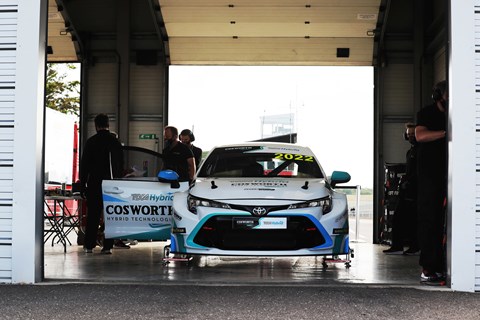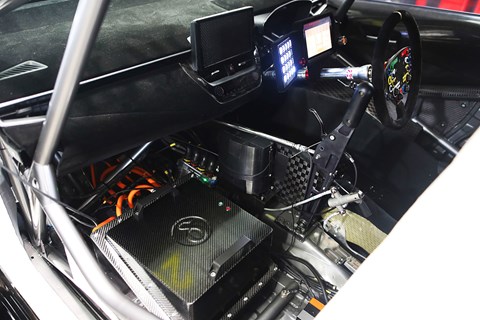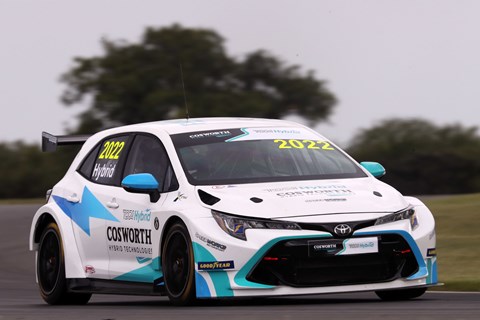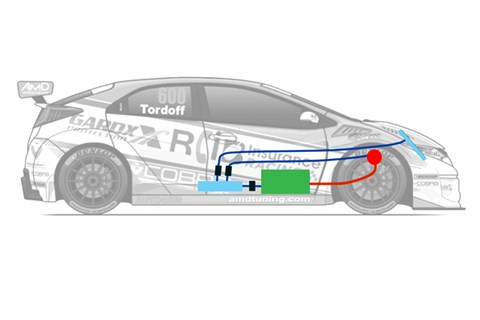► BTCC goes hybrid in 2022
► Testing starts with Corolla
► Electrified racer tech explained
The BTCC grid of 2022 will look a lot like the BTCC grid of 2020. But under the skin of the race-prepared hot hatches and saloons there will be three modest bits of hardware that promise fresh excitement, interest and relevance to the long-running series.
While some other championships are tangling themselves up in rule changes and vague promises of going green, BTCC has mapped out a clear plan for its next evolution.
The very safe pair of hands leading the transformation belongs to Cosworth, the Northampton-based engineering operation that over 60-plus years has been hugely successful in F1, Indycar and beyond. Its electronics division has come up with a hybrid kit – battery, cooling system and an electric motor – that’s simple, universal and affordable.

Cosworth’s motorsport programme manager, Tom Brown, says the advantages of hybridisation will include more power, better performance and closer racing. The teams and drivers are on board, and on-track testing has just begun with BTCC and Le Mans veteran Darren Turner at the wheel.
And, crucially, it’s not wildly expensive, unlike some of the hybrid systems seen in F1 and endurance racing. ‘In LMP1 the budgets were astronomical – over and above what people were spending in F1,’ says Brown. ‘The hybrid system that we are leasing to every team is £20,500 per kit per season. It is the first [motorsport] hybrid system that’s cost-effective.’
Development work began last summer, initially using computer simulations. At the request of series organisers TOCA, the aim is to give the driver enough extra boost per lap to enable him to catch a rival on a long straight, or defend his position, but not so much that he’ll easily overtake.
‘That’s how we came up with the figure of 40bhp for 15 seconds,’ explains Brown. ‘Once you’ve got that loose specification it’s then about working backwards. We know we need 40bhp. So what voltage do we need? What power do we need to get out of the electric motor? What does the battery capacity need to be?’ Bench testing followed, and then the first track test at Snetterton with Turner and a Toyota Corolla.

As well as giving drivers extra power, the hybrid system will also replace BTCC’s often-controversial ‘success ballast’, where doing well in one race means you carry a heavier load in the next. From 2022, it will be tweaks to the hybrid system that level the playing field. Cosworth is also working on an LED system to be mounted in the cars to inform the TV audience of exactly what’s going on. ‘You can see that maybe someone hasn’t got as much regen, or that they’re running out of deployment per lap.’
The 2022 switch to hybrid power should chime with the road-car experience of many spectators. Like BTCC drivers, they must juggle power and range: ‘People understand regen. It’s becoming a common term,’ says Brown. Cosworth is exploring ways to let drivers select different strategies. If you’re stuck in traffic, for instance, it might make sense to go to max regen – the car in front’s holding you up anyway, and the boost you build up could help you pass when the track clears.

Paddock practicalities have been factored in: the quick-release battery can be charged up in an hour using a wall socket – or charged by doing the warm-up lap on the highest level of regen. Cars will leave the pitlane running on electric-only.
‘It’s really advanced compared to what other series are doing. Australian Supercars are watching what the BTCC is doing. The TCR series are watching,’ says Brown. ‘When it comes to hybrids, TOCA are a long way ahead of the curve.’
Inside a 2022 hybrid touring car

The hybrid hardware has been designed to slot into today’s touring cars with minimal modification. Every car gets the same kit from Cosworth, with only tiny differences between front- and rear-drive versions. Cosworth is testing with Speedworks, which runs the Toyota Gazoo Racing UK Corolla, but the end result will be universal.
Cosworth engineers will attend every team’s initial installation process, and will be available at every round to help with any problems that may arise (just as Cosworth already does in its capacity as provider of BTCC’s standard electronics). At the end of each season it will take the hybrid kit back for a refurb.
Cooling system (blue)
Australian specialists PWR supply Cosworth with the cooling kit for the electric motor.
Electric motor (red)
Weighs 7.5kg, adds 40bhp to the 300bhp from the 2.0-litre four, integrates with the Xtrac six-speed sequential ‘box.
Battery pack (green)
60-volt battery from Silverstone-based Delta Motorsport weighs 20kg and sits in a composite safety cell, replacing ballast.
60-volt loom (orange)
A relatively low voltage makes the hybrid system safer to handle.
Check out more CAR tech news here